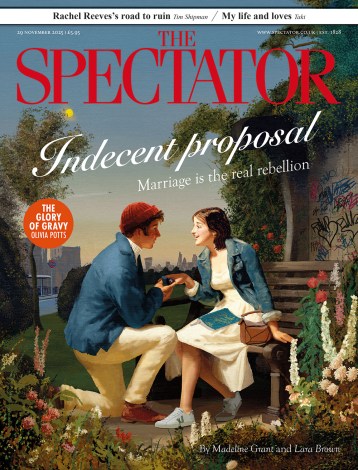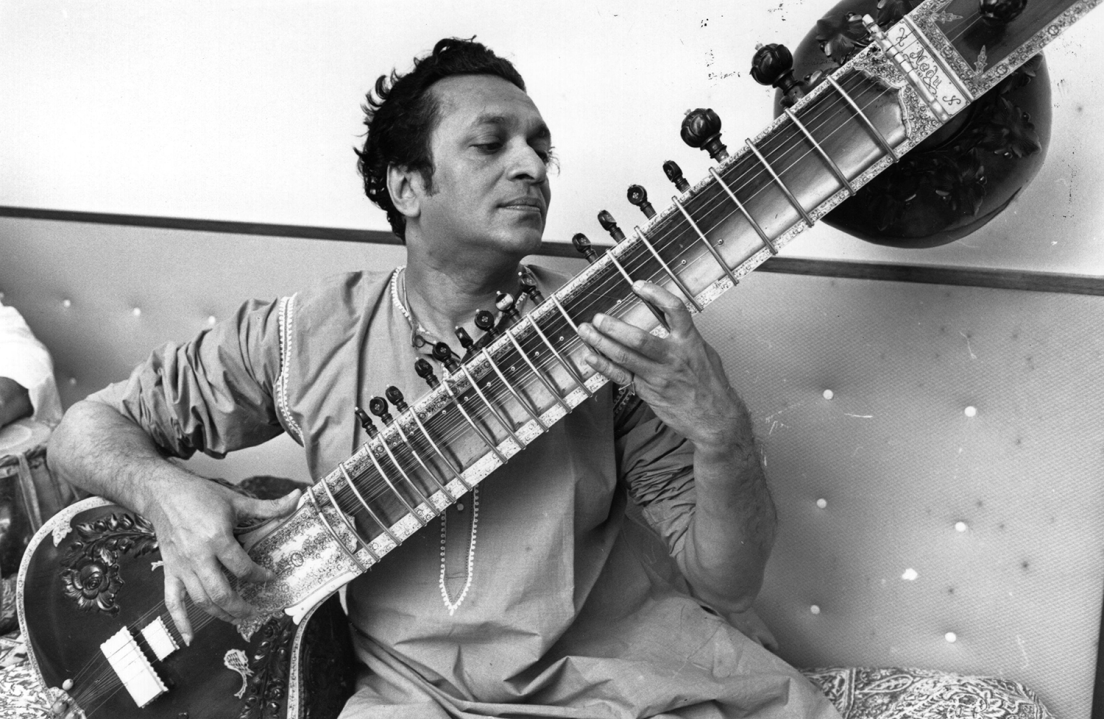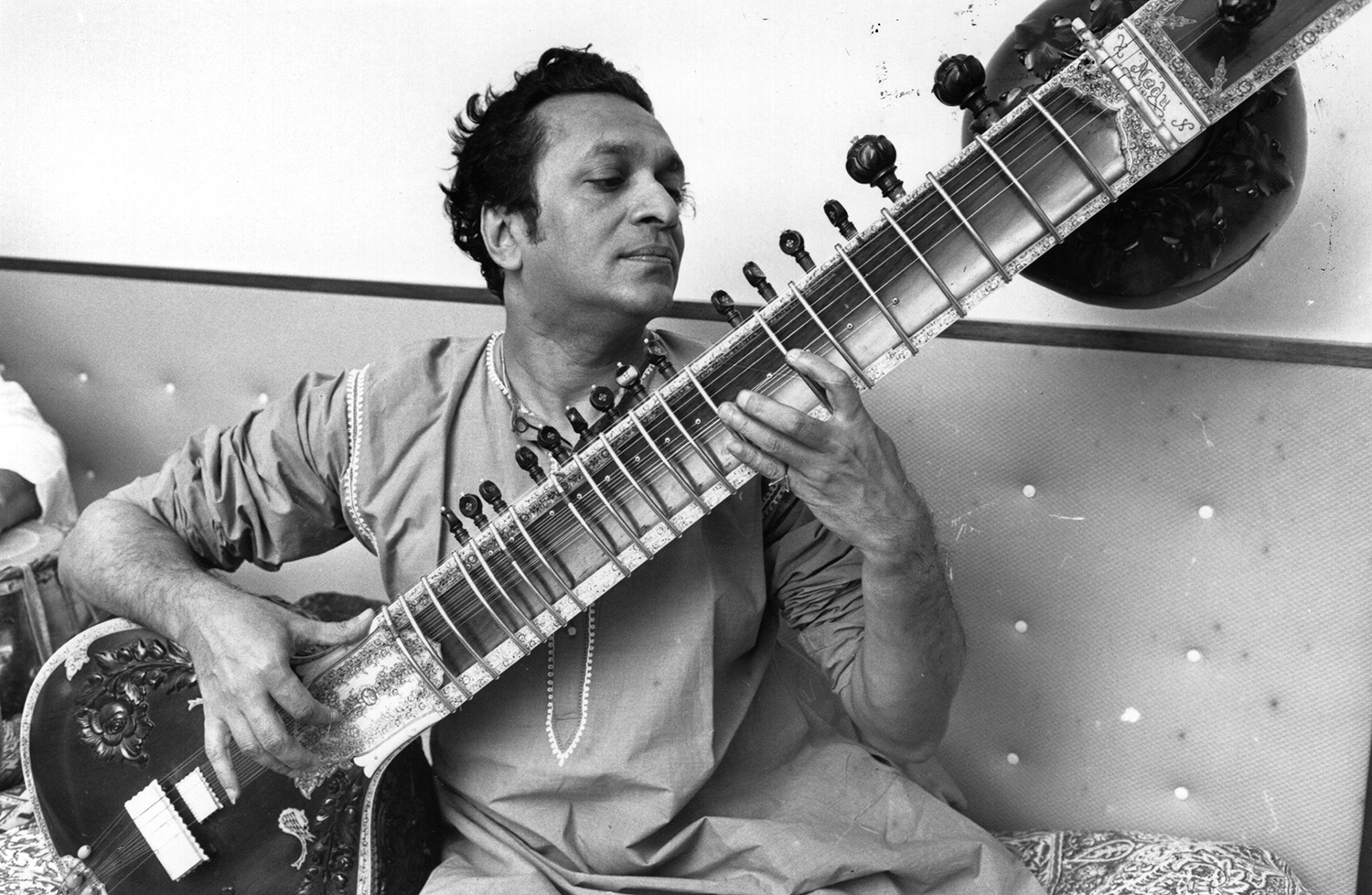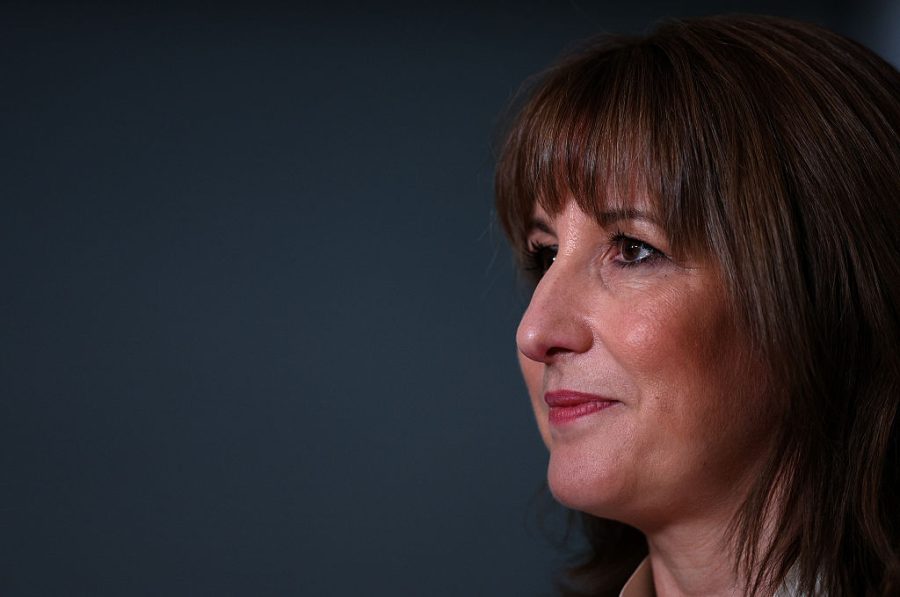
When Gurdain Ryatt, Ojas Adhiya, Milind Kulkarni and Murad Ali Khan take to the stage at Milton Court this Sunday they will be united by a common language: the tradition of Hindustani Indian classical music, rooted in the north of India. Ryatt and Adhiya’s job will be to keep beats circulating on their pitched, drum-like tablas, while Kulkarni’s harmonium will sustain drones, apparently towards infinity. Khan plays the sarangi, a string instrument famed for its uncanny invocation of the wavering of the human voice.
Shankar’s tireless advocacy spawned a crossover culture that he felt too often sullied the very music he loved
British audiences have a head start when it comes to appreciating this tradition. The charismatic sitar player Ravi Shankar, who became the very personification of Indian classical music in the way that Louis Armstrong had become synonymous with jazz, played his first major British concert at the Royal Festival Hall in 1958 and, some repeat visits later, everyone from Benjamin Britten to George Harrison made it their business to have an opinion about him. Despite Britain’s colonial past, Indian culture had remained a niche concern after the war. But then came Shankar and by the early 1970s, Madhur Jaffrey, whose book An Invitation to Indian Cookery, created a taste, then a craze, for Indian cuisine.
Indian classical music, just like Indian food, were changed when they landed on these shores. The sounds of Shankar’s sitar captivated Yehudi Menuhin, who knew a thing or two himself about string playing. Their friendship begat a sequence of Menuhin/Shankar duo albums, a spirit that led to Shankar recording his Concerto for Sitar and Orchestra with André Previn and the London Symphony Orchestra. Anyone who had Jaffrey’s book on their shelves was also likely to own the Menuhin and Shankar album West Meets East. Indian music found itself sucked inside British culture, but Shankar’s concerts at the Royal Festival Hall also became one of the hottest tickets in town.
Shankar, who died in 2012 aged 92, maintained stratospherically high performance standards throughout his long career – he recorded his first album in 1956, and played concerts almost to his last days. But his tireless advocacy spawned a crossover culture that he felt too often sullied the very music he loved. He notably failed to serve up the praise George Harrison so coveted for his sitar playing on ‘Norwegian Wood’ from the Beatles’s 1965 Rubber Soul album; there was not much to praise, Shankar reasoned. But having the Beatles in his corner helped him land a plum gig at the Monterey International Pop Festival in 1967, an appearance that pushed his star even further into the ascendent, although Shankar was horrified at the drug-taking, and looked on with bemused sadness as Jimi Hendrix torched his guitar on-stage.
The questions raised about how far a musical tradition can be flexed before it snaps haven’t gone away. This summer Ravi’s daughter, Anoushka Shankar, brought her composition Chapters to the Proms, a piece fluent in pop and dance music, and with an ear to minimalism, that placed her sitar inside the weight of classical orchestration. Then last month I sat in the Royal Festival Hall – where nearly 70 years earlier Shankar had sealed the deal with his British audience – watching Rishab Sharma, billed as Shankar’s ‘last disciple’, whose evening of ‘Sitar for Mental Health’ promised ‘digital visuals and raw emotional storytelling’ and music that was ‘mindful and healing’.
Western music obsesses over narrative and story, while the music of the Hindustani tradition is wrapped up in the mystery of ritual and process. Opera goers in the West actively want to be transported to a different time and place, but the system of ragas that for centuries has underpinned Indian classical music pegs a performance to the actual moment in which it takes place: for instance Megh Malhar for the monsoon season or Bahar for spring. Listen to ‘Winter’ from the Four Seasons during the suffocating heat of high summer and Vivaldi’s notes still exist as a representation of ice and frost, but playing a raga out of season would be considered nonsensical – the equivalent of talking in the past tense about something happening in the future.
Ragas are often mistakenly described as scales over which musicians improvise, like the scales and chords jazz musicians use to orientate their improvisations. This is a misnomer – as is the idea that ragas are melodic lines, or full compositions that Indian musicians vary, like a western theme and variations. Shankar himself identified ragas not as melodies per se, but as melodic forms – each raga a blueprint, handing musicians all the information they needed to sustain their melodic invention. Each raga was contoured by prominent notes to be stressed while playing which, by definition, meant that other notes became less intrinsic to its character. But unlike western scales, based around consistent patterns, each raga had its own bespoke intelligent design. In his autobiography, Raga Mala, Shankar explained how ragas were a ‘projection of the artist’s inner spirit’ – they centred a musician in the moment.
There are no written scores in the tradition, nor is the music ‘improvised’ in the way improvisation is understood here. Ragas are passed down through the generations aurally, gurus teaching disciples who spend years learning how to zone in on the minutiae of listening, how to feel sound. Western music proves so adept at storytelling because even the most tangled harmonies can – usually – be made to resolve; the music is always heading home. Part of the great learning of Hindustani music is resisting the temptation to make ragas conclude or end. The intricacies of tunings used by Indian musicians – the scale divided up into many more notes than in the West – means that a wider array of paths can be taken before any mad dash towards home. Indian musicians are minded to keep their sounds spinning through time, floating on a bed of vibrating tones. Indian classical music never ends. It simply stops – albeit sometimes after the many hours it can take a raga to exhaust its possibilities.
He was alarmed to see stoned hippies because he considered his music to be mind-expanding in itself
That word ‘classical’ comes loaded with so many expectations that definitions are prone to getting muddled. When he toured Russia, Shankar took umbrage at being introduced as a ‘folk’ musician. His music was ‘classical’ in the sense that it was rooted in a musical vocabulary and way of being with sound that had painstakingly been handed from generation to generation over centuries. At Monterey, Shankar was alarmed to see stoned hippies because he considered his music to be mind-expanding in itself, never mere background music for personal hedonism. After all, nobody went to a Vladimir Horowitz gig to get stoned.
Another way in which east didn’t meet west: in Indian music, no divide exists between composer and performer. There are no composer-types pushing the music towards avant-garde deconstruction. Western composers who have engaged with Indian music, including Terry Riley, a disciple of vocalist Pandit Pran Nath, and the proto-minimalist La Monte Young – both 90 this year – were drawn towards its rituals precisely because it offered another perception of passing time and an undoing of the forward-momentum of western classical music.
On Sunday, Ryatt and Kulkarni will play the first half of their concert as a duo, then Adhiya and Khan will play together after the interval, and listeners with ears attuned more to Beethoven and Mahler will need to adjust their expectations of pacing and of how sound can breathe. Listening to Rishab Sharma’s ‘Sitar for Mental Health’ concert last month, with its screen saver-like visual backdrops, and an introductory video outlining his own mental-health problems, I felt that this was a show served up for the TikTok generation; Sharma is a fine sitar player, but with the ritualistic concentration replaced by digital and intellectual wallpaper, the music becomes a mere trinket box of bejewelled sounds. Anoushka Shankar’s Chapters similarly came alive when her sitar was in full flow, but the orchestral padding too often sounded like generic scene-setting.
Ravi Shankar always maintained that Indian classical music contained the essence of ‘something very deep’; that the music was unique because of its ‘spiritual, devotional, soothing’ properties, which need more time to catch their flow than western music generally allows. Surrendering to the process is a quiet rebellion against digital modernity – a reminder that some experiences deserve to be savoured, not rushed.
Darbar: Tabla solo by Gurdain Rayatt + Murad Ali Khan is at Milton Court Concert Hall on 30 November, as part of Darbar Festival. Anoushka Shankar’s album Chapter III: We Return to Light is out now.








Comments